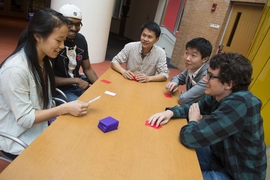A graduate student doing research on materials for circuit design might not share lab space with someone working on machine learning, but they still have a shared need: to explain what they’re working on to other people. Whether it’s to their advisor, a room full of their peers, a startup accelerator, a project’s funders, or Uncle Frank — at some point everyone who does research is faced with an audience.
And so here comes CommKit, a new online resource poised to make the lives of engineering graduate students easier. Launched on Sept. 22, the CommKit is a website that provides discipline-specific aid to those seeking writing, speaking, and visual design support on a tight deadline. Designed for engineers by engineers — specifically, 50 graduate students who have been working as department- and area-based peer coaches at the MIT Communication Lab — the CommKit was designed to demystify effective scientific communication.
Like most good ideas at MIT, the one for CommKit started with students. While doing peer coaching sessions, graduate students Diana Chien and Scott Olesen, discovered themselves answering many of the same questions, or providing many of the same examples and templates, over and over again. “I remember how overwhelmed I felt as an early graduate student writing abstracts and fellowships,” says Chien. “I googled frantically for support, but the advice I found was scattered randomly and rarely relevant to my field.”
Chien and Olesen approached Jaime Goldstein, who directs the Communication Lab (or Comm Lab), about developing a solution to the need for a consistent go-to resource. The resulting website is organized first by department, and then by communication task — such as poster, grant application, manuscript, or oral presentation. Each task page includes quick tips, structural diagrams, and annotated field-specific examples. “We’re scientists and engineers,” Olesen says. “We thought like scientists and engineers when making the CommKit.”
Enthusiasm about the CommKit, and the Comm Lab’s peer coaching model, is already getting attention beyond campus. “Effectively communicating technical information is a key determinant of the success of students and postdocs at Caltech,” says Trity Pourbahrami, from the Caltech Engineering and Applied Science Division. “I’ve been delighted to connect with the MIT Communication Lab community and look forward to sharing the CommKit with the Caltech community.”
Goldstein, who has directed the Comm Lab since its inception in 2012, says the development of an online resource marks an innovative step forward. The site will continue to evolve, she adds, just as the Comm Lab’s programming has changed and broadened over time so that it could serve more students and be more effective.
Started initially as a cocurricular support program within the Department of Biological Engineering, the Comm Lab has since expanded to include the Department of Nuclear Science and Engineering, Department of Electrical Engineering and Computer Science, and the Broad Institute. This semester, the program is working with the Sandbox Innovation Program to develop expertise, and coaches, to support students with an interest in innovation.
Each time the program expands to a new department or field, Goldstein adds coaches and content so the program is always immediately relevant for the students it’s there to serve. “Communications can be a very broad topic, but students don’t experience it that way,” Goldstein says. “For them — and for the Comm Lab coaches — it’s about specific tasks, projects, and skills. Students crave help improving things like fellowship applications, grant proposals, and posters, so that’s where we focus our efforts.”









